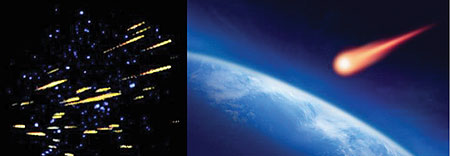A Meteoroid is a small stony body drifting through space. If a meteoroid is pulled into a planet’s or moons gravitational field, it is called a meteor. If the meteor survives a trip through the atmosphere and lands, it is called a meteorite.


A Meteoroid is a small stony body drifting through space. If a meteoroid is pulled into a planet’s or moons gravitational field, it is called a meteor. If the meteor survives a trip through the atmosphere and lands, it is called a meteorite.
They are always ever orbiting the sun like other planets. Meteoroids are notably smaller than asteroids. They are commonly made up of rock forming minerals such as quartz or ferrous metals like iron.
If a rock like that to hit the Earth, it would never reach the ground. Earth’s atmosphere protects us said one American scientist by the names of Cooke.
"A 10-inch meteoroid would disintegrate in mid-air, making a spectacular fireball in the sky but no crater.” The Moon is different. Having no atmosphere, it is totally exposed to meteoroids. Even small ones can cause spectacular explosions, spraying debris far and wide leaving behind great impacts and craters like it always happens.
Meteors are bits of material falling through Earth’s atmosphere; they are heated to incandescence (emission of visible light from a substance or object as a result of heating it to a high temperature) by the friction of the air.
The bright trails as they are coming through the Earth’s atmosphere are termed meteors, and these chunks as they are hurtling through space are called meteoroids. Large pieces that do not vaporize completely and reach the surface of the Earth are termed meteorites.
Scientists estimate that 1,000 tons to more than 10,000 tons of meteoritic material falls on the Earth each day. However, most of this material is very tiny - in the form of micrometeoroids or dust-like grains a few micrometers in size. (These particles are so tiny that the air resistance is enough to slow them sufficiently that they do not burn up, but rather fall gently to Earth.)
Where do they come from?
According to scientists, they probably come from within our own solar system, rather than outer space. Their composition provides clues to their origins.
They may share a common origin with the asteroids. Some meteoritic materials are similar to the Earth and Moon and some are quite different. Some evidence indicates an origin from comets.
Several "shooting stars” or meteors per hour can usually be seen on any given night. Sometimes the number of meteors seen increases dramatically: these are termed "meteor showers”.
In fact, some meteor showers occur annually or at rather regular intervals. The number is greater in autumn and winter. The number always increases after midnight and is usually greatest just before morning hours.
Meteorites may look very much like Earth rocks according to scientists, or they may have a burned appearance. They may be dense metallic chunks or more rocky. Some may have thumbprint-like depressions, roughened or smooth exteriors.
They vary in size from micrometer size grains to large individual boulders. The largest individual iron is the Hoba meteorite found in southwest Africa which has a mass of about 54,000 kg.
The stones are much smaller, the largest fell in Norton County, Kansas USA having a mass of about 1,000 kg. Considering the vast in fall of meteorites, one can wonder if anyone has been hurt or killed by meteorites.
There are only a few documented cases on record. A shower of stones fell upon Nakhla, near Alexandria, Egypt on June 28, 1911, one of which allegedly killed a dog.
On November 30, 1954, Mrs. Hewlett Hodges of Sylacauga, Alabama was severely bruised by an 8 pound stony meteorite that crashed through her roof. This is the first known human injury.
Most meteoritic samples are either iron or stony, which are predominately rocky-silicates; or stony-iron.
While most meteors burn up before reaching the Earth’s surface, many meteoroids break apart in the upper atmosphere, and become «fluffy meteors». This «fluffy» nature indicates a loose structure or vapour grown crystal aggregates.
This gives rise to theories that some meteoroid material was aggregated, some subjected to heating-vaporization-condensation. This contrasts with the idea that meteoroids originated from an exploded planet or planetoid or asteroid.
Sixteen meteorites have been found in Antarctica that are believed to have originated on the planet Mars.
Gases trapped in these meteorites scientists said they matched the composition of the Martian atmosphere as measured by the spacecraft Viking, which landed on Mars in the mid-1970s.


